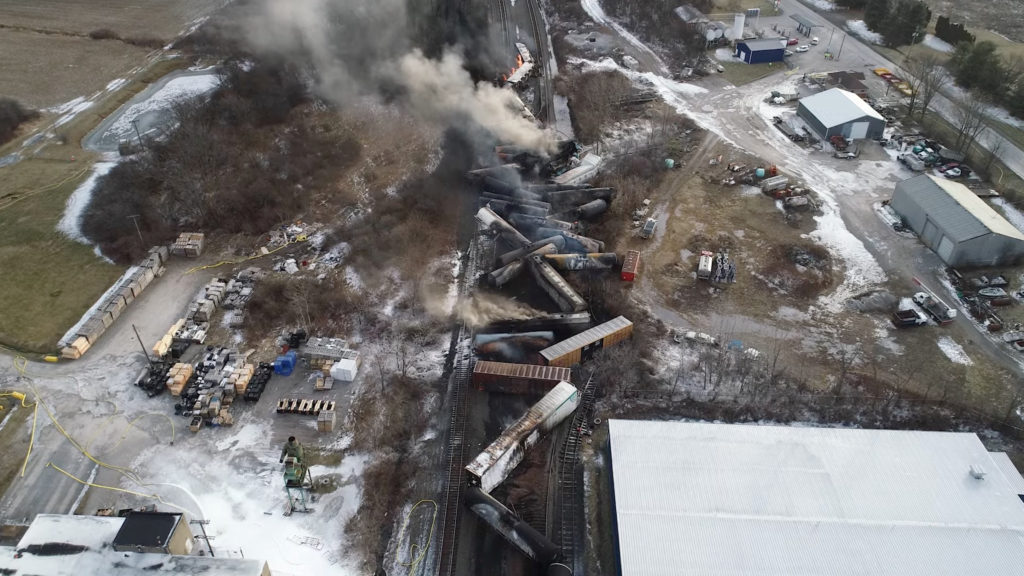Long-Term Effects Of Ohio Train Derailment: Toxic Chemical Contamination Of Buildings

Table of Contents
Types of Chemical Contamination and Their Impact on Buildings
The Ohio train derailment released a cocktail of toxic chemicals, with vinyl chloride and butyl acrylate being among the most concerning. These chemicals, known for their volatility and potential health hazards, can significantly impact building materials and indoor environments.
-
Vinyl Chloride: This colorless gas is a known carcinogen, meaning it can cause cancer. It can penetrate porous building materials like wood, drywall, and insulation, leaving behind persistent residues. Long-term exposure to vinyl chloride can lead to various health problems, including liver damage and several types of cancer.
-
Butyl Acrylate: This colorless liquid with a pungent odor is an irritant to the eyes, skin, and respiratory system. It can also penetrate building materials, leading to lingering contamination and ongoing exposure risks. Inhalation can cause respiratory distress, and skin contact can lead to irritation and allergic reactions.
-
Other Chemicals: The derailment also released other potentially harmful chemicals, including ethylene glycol monobutyl ether, which can affect the nervous system and cause reproductive harm. The interaction of these chemicals and their long-term effects on building materials and inhabitants require further investigation.
The penetration of these chemicals into building materials can lead to several problems:
- Structural Degradation: Chemical reactions with building materials can weaken structural integrity over time, increasing the risk of damage or collapse.
- Air Quality Issues: The off-gassing of these chemicals can lead to poor indoor air quality, causing respiratory problems and other health issues for residents.
- Water Contamination: If chemicals leach into the ground, they can contaminate water supplies used for drinking and household purposes, posing a significant health risk.
Assessing and Monitoring the Extent of Contamination
Accurately assessing the extent of contamination from the Ohio train derailment presents a significant challenge. The complexities involved require a multifaceted approach employing various testing methods:
-
Environmental Testing: This includes air quality monitoring, water testing, and soil analysis to determine the presence and concentration of hazardous chemicals in different environmental media.
-
Building Material Testing: Specialized techniques may be required to assess the level of chemical penetration within building materials, potentially requiring destructive testing in some cases.
-
Long-Term Monitoring: Continuous monitoring is crucial to track the spread and persistence of chemicals over time. This requires ongoing testing and analysis to evaluate the effectiveness of cleanup efforts.
However, limitations exist:
-
Technology Limitations: Current testing methods may not detect all chemicals or accurately quantify their long-term impact. Advanced technologies and further research are crucial to enhance accuracy.
-
Data Transparency: Ensuring transparency in data collection, analysis, and reporting is vital to build public trust and guide effective remediation strategies. Independent verification of results is necessary to avoid potential bias.
Long-Term Health Implications for Residents
The health risks associated with exposure to the chemicals released in the Ohio train derailment are significant, with long-term consequences potentially impacting multiple generations:
-
Cancer Risk: Exposure to vinyl chloride and other carcinogens increases the risk of developing various cancers.
-
Respiratory Problems: Exposure to irritants like butyl acrylate can lead to chronic respiratory illnesses like asthma and bronchitis.
-
Reproductive Health: Certain chemicals can negatively affect reproductive health, potentially causing birth defects or infertility.
-
Neurological Effects: Exposure to some chemicals can have long-term neurological consequences, particularly affecting children’s development.
Comprehensive medical monitoring of affected residents is essential to track the development of health problems and implement appropriate medical interventions. The psychological impact on the community also needs to be addressed through mental health support services.
Remediation and Cleanup Efforts
The cleanup process following the Ohio train derailment is extensive and faces numerous challenges:
-
Decontamination of Buildings: Remediating contaminated buildings requires specialized techniques, potentially including demolition in severely affected cases. This process is costly and time-consuming.
-
Soil and Water Remediation: Contaminated soil and water sources need to be addressed to prevent further spread of chemicals and long-term environmental damage.
-
Government Response and Community Involvement: Effective cleanup requires a coordinated effort between government agencies, environmental experts, and the affected community. Open communication and community participation are essential for successful remediation.
The financial burden of cleanup and rebuilding falls heavily on the affected community, requiring substantial government funding and potentially long-term support programs.
Conclusion
The long-term effects of the Ohio train derailment, particularly the toxic chemical contamination of buildings, present a significant challenge. Comprehensive testing, effective remediation, and ongoing monitoring are crucial to mitigate the risks to public health and the environment. The need for transparency and accountability in the cleanup process is paramount. Understanding the potential long-term impact of toxic chemical contamination from the Ohio train derailment is vital. Stay informed about ongoing developments, advocate for robust cleanup efforts, and demand transparency from officials regarding the health and safety of affected communities. Continue to monitor news sources and official reports on the Ohio train derailment's long-term effects to stay updated on the situation and potential impacts.

Featured Posts
-
 Bond Traders Rate Cut Optimism Powells Speech Changes The Outlook
May 12, 2025
Bond Traders Rate Cut Optimism Powells Speech Changes The Outlook
May 12, 2025 -
 The Impact Of Johnson On Track And Field Duplantis Diamond League Performance Analyzed
May 12, 2025
The Impact Of Johnson On Track And Field Duplantis Diamond League Performance Analyzed
May 12, 2025 -
 Press Charges Filed Marjolein Faber And The Hitler Mustache Photo Controversy
May 12, 2025
Press Charges Filed Marjolein Faber And The Hitler Mustache Photo Controversy
May 12, 2025 -
 Karlyn Pickens Record Breaking 78 2 Mph Pitch A Tennessee Softball Milestone
May 12, 2025
Karlyn Pickens Record Breaking 78 2 Mph Pitch A Tennessee Softball Milestone
May 12, 2025 -
 Todays Comic News Superman Daredevil Bullseye And 1923
May 12, 2025
Todays Comic News Superman Daredevil Bullseye And 1923
May 12, 2025
